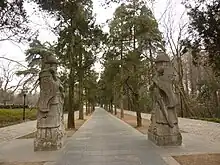

Ruan Wengzhong (Ch:阮翁仲) was a Chinese hero of the Qin Dynasty, who fought against the Xiongnu on the Great Wall at the border city of Lintao. He was allegedly a 3 meters tall giant. His story was first mentioned by the 3rd century CE writer Gao You in his commentary of the Huainanzi, and later developed in the 6th century Commentary on the Water Classic:[1][2]
In the 26th year of the First Emperor of Qin's reign, with all under heaven having just been annexed, there was a giant who appeared in Lintao. He was 5 zhang and his footprint was 8 chi long. So an image was drawn of him, and a metal statue was cast of his likeness. This was Wengzhong Junhe
The First Emperor of China Qin Shihuang built a giant bronze statue of his likeness, in addition to his more famous Twelve Metal Colossi, by melting the bronze weapons captured in his victory over the Six Kingdoms. The statue was placed outside his Imperial Palace at Xianyang, near Xi'an.[1]
"Wengzhong" has become a generic term for large scale statues of bronze and stone, and for jade statuettes placed within the coffin of the dead.[1][3]
References
- 1 2 3 Li, Xifan (3 October 2022). A General History of Chinese Art: From the Qin Dynasty to the Northern and Southern Dynasties. Walter de Gruyter GmbH & Co KG. pp. 73–74. ISBN 978-3-11-079088-7.
- ↑ Anderson, James A.; Whitmore, John K. (6 November 2014). China's Encounters on the South and Southwest: Reforging the Fiery Frontier Over Two Millennia. BRILL. ISBN 978-90-04-28248-3.
- ↑ Man, John (31 October 2010). The Terracotta Army. Transworld. p. 320. ISBN 978-1-4090-4561-8.